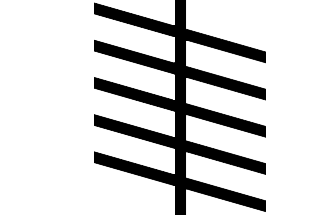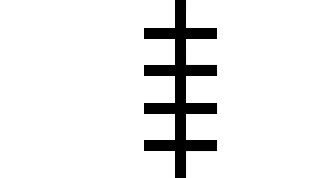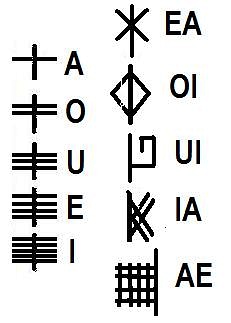I love David McLansky’s “Vines” That’s beautiful. And your lovely wreath!!
It’s beautiful just the way it is!
Great info. I love Birch trees, specially dried when they crackle in the fire.
Thank you!
It’s beautiful!
Thank you:)
@Satu_TheGreenWitch Great information on the Ogham Muin. I love fresh blackberries off the vine too  Great entry & wreath! @MeganB does Ogham posts with the meanings of them & I believe the staves also (which I have seen done in acorns!)
Great entry & wreath! @MeganB does Ogham posts with the meanings of them & I believe the staves also (which I have seen done in acorns!)
@christine13 that is a lovely broom/besom, I think it looks great the way that you have it now! 
I loved this challenge!!!
I came across this artwork Thursday of last week, and with this challenge. Was so blown away by this. Personally, love seeing the moon during the day, with the blue sky behind it, so pretty, and trees, a few of my favorites things. Credit: the artist is Stefan Hillinger, and his IG is @stefan_hillinger where I got this artwork from.
@sarah29 after I picked my jaw up off the floor I gave you a standing ovation! How brilliant to do this with your Christmas tree. I am thinking of all the poor trees I saw laying on the side of the road a few weeks ago. Very cool. 
Am I going to be collecting poor baby discarded Christmas trees off the side of the road next year? I have a whole summer to prepare my husband for this
@jessica72 You did an awesome job displaying your drumstick! My sister also has drumsticks that she has collected from concerts, but none of them are as honored as yours. I think your idea for this week is very creative and out of the box.
That took my breath away! Absolutely beautiful!
@janis Don’t you love it when a plan comes together ![]()
@Kasandra In my younger years I resisted change. I would make myself sick with stress. I still like to park in the same parking spot every day but going with the flow changed my freaking life. Beautiful affirmation to the maple tree.
@Eliza_01 that is a gorgeous picture - I am jealous - I want this. Thank you for the instragram link
@Satu_TheGreenWitch You did great! Welcome ![]() can’t wait to see more of your work!
can’t wait to see more of your work!
@christine13 Your broom turned out so so cute. The dried Rose really makes it lovely.
Ogham
by Jenni Irving
One of the stranger ancient scripts one might come across, Ogham is also known as the ‘Celtic Tree Alphabet’. Estimated to have been used from the fourth to the tenth century CE, it is believed to have been possibly named after the Irish god Ogma but this is debated widely. Ogham actually refers to the characters themselves, the script as a whole is more appropriately named Beith-luis-nin after the order of alphabet letters BLFSN.
Description
The script originally contained 20 letters grouped into four groups of five. Five more letters were later added creating the fifth group. Each of these groups was named after its first letter. There are some four to five hundred surviving ogham inscriptions throughout Britain and Ireland with the largest number appearing in Pembrokeshire. The rest of the inscriptions were located around south-eastern Ireland, Scotland, Orkney, the Isle of Man, and around the border of Devon and Cornwall. Ogham was used to write in Archaic Irish, Old Welsh, and Latin mostly on wood and stone and is based on a high medieval Briatharogam tradition of ascribing the name of trees to individual characters. The inscriptions containing Ogham are almost exclusively made up of personal names and marks of land ownership.
Origin Theories
There are four popular theories discussing the origin of Ogham. The differing theories are unsurprising considering that the script has similarities to ciphers in Germanic runes, Latin, the elder futhark and the Greek alphabet.
The first theory is based on the work of scholars such as Carney and MacNeill who suggest that Ogham was first created as a cryptic alphabet designed by the Irish. They assert that the Irish designed it in response to political, military, and/or religious reasons so that those with knowledge of just Latin could not read it.
THE SCRIPT HAS SIMILARITIES TO CIPHERS IN GERMANIC RUNES, LATIN, ELDER FUTHARK, AND THE GREEK ALPHABET.
The second theory is held by McManus who argues that Ogham was invented by the first Christians in early Ireland in a quest for uniqueness. The argument maintains that the sounds of the primitive Irish language were too difficult to transcribe into Latin.
The third theory states that the Ogham script from invented in West Wales in the fourth century BCE to intertwine the Latin alphabet with the Irish language in response to the intermarriage between the Romans and the Romanized Britons. This would account for the fact that some of the Ogham inscriptions are bilingual; spelling out Irish and Brythonic-Latin.
The fourth theory is supported by MacAlister and used to be popular before other theories began to overtake it. It states that Ogham was invented in Cisalpine Gaul around 600 BCE by Gaulish Druids who created it as a hand signal and oral language. MacAlister suggests that it was transmitted orally until it was finally put into writing in early Christian Ireland. He argues that the lines incorporated into Ogham represent the hand by being based on four groups of five letters with a sequence of strokes from one to five. However, there is no evidence for MacAlister’s theory that Ogham’s language and system originated in Gaul.
Mythical theories for the origin of Ogham also appear in texts from the eleventh to fifteenth centuries. The eleventh-century Lebor Gabala Erenn tells that Ogham was invented soon after the fall of the tower of Babel, as does the fifteenth century Auraicept na n-eces text. The Book of Ballymote also includes ninety-two recorded secret modes of writing Ogham written in 1390-91 CE.
Source of Information
World History.org
Interesting was that I could spell my name in this old ancient language:
 |A|
|A|
 |R|
|R|
 |B|
|B|
 |E|
|E|
 |D
|D
THE SCRIPT HAS SIMILARITIES TO CIPHERS IN GERMANIC RUNES, LATIN, ELDER FUTHARK, AND THE GREEK ALPHABET.

Diagram source World History.org
The vowels of the ogham. Note: This is the vertical writing of ogham. In the horizontal form, the right side would face downward.
MOD NOTE: The writing shared here was shared under a Creative Commons Attribution-NonCommercial-ShareAlike license through World History Encyclopedia. It is free and legal to distribute with proper source credit.
Irving, J. (2012, May 11). Ogham. World History Encyclopedia . Retrieved from Ogham - World History Encyclopedia
I have so much to talk with you about trees, haha. 
This is incredible oh my gosh my notebook is exploding 
Thank you @LadyAuld.ofChico I loved it that I could spell my own name. So interesting!
I realize that I am cutting this close, but I just saw this or the email for it. I’m still having computer issues and so I don’t get to get on Spells8 as much as I would like to but I digress.
A while back, I ordered a rowan branch from someone in Latvia and I started working on my wand. I am not finished with it quite yet but I can post a pic if you want?
Rowan is my birth tree not to mention the magical properties it has. I kept the Rowan bark when I smoothed it out for spells I might need it in. I’ll have to post a pic at a later time. I can’t get to my cupboard I keep my supplies in at the moment. Long story…but I DO use wood in my practice when I can and I want to learn more about being a green witch and the ogham etc.
I posted my challenge entry here: https://forum.spells8.com/t/my-sacred-trees-and-wood-challenge-entry/18341
